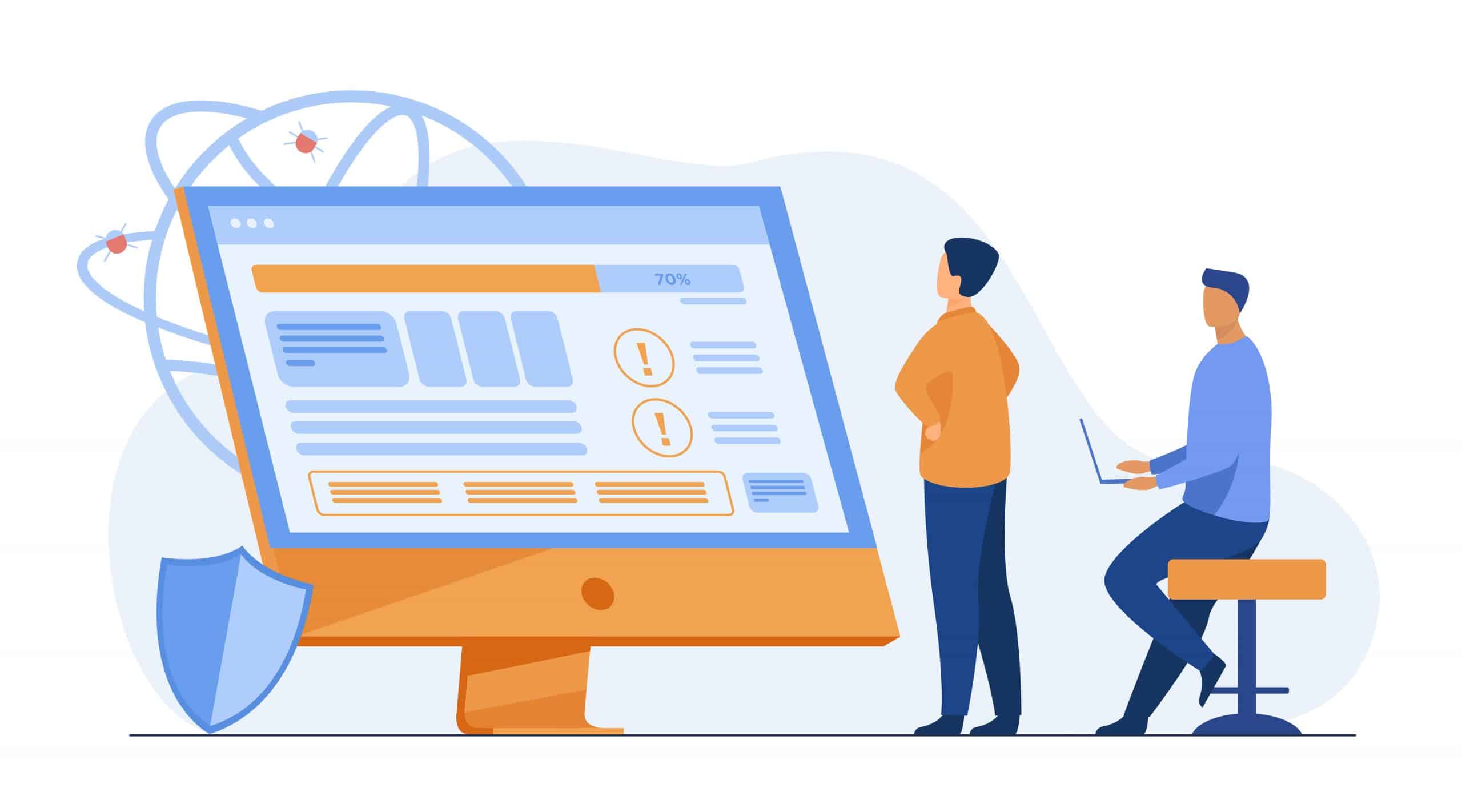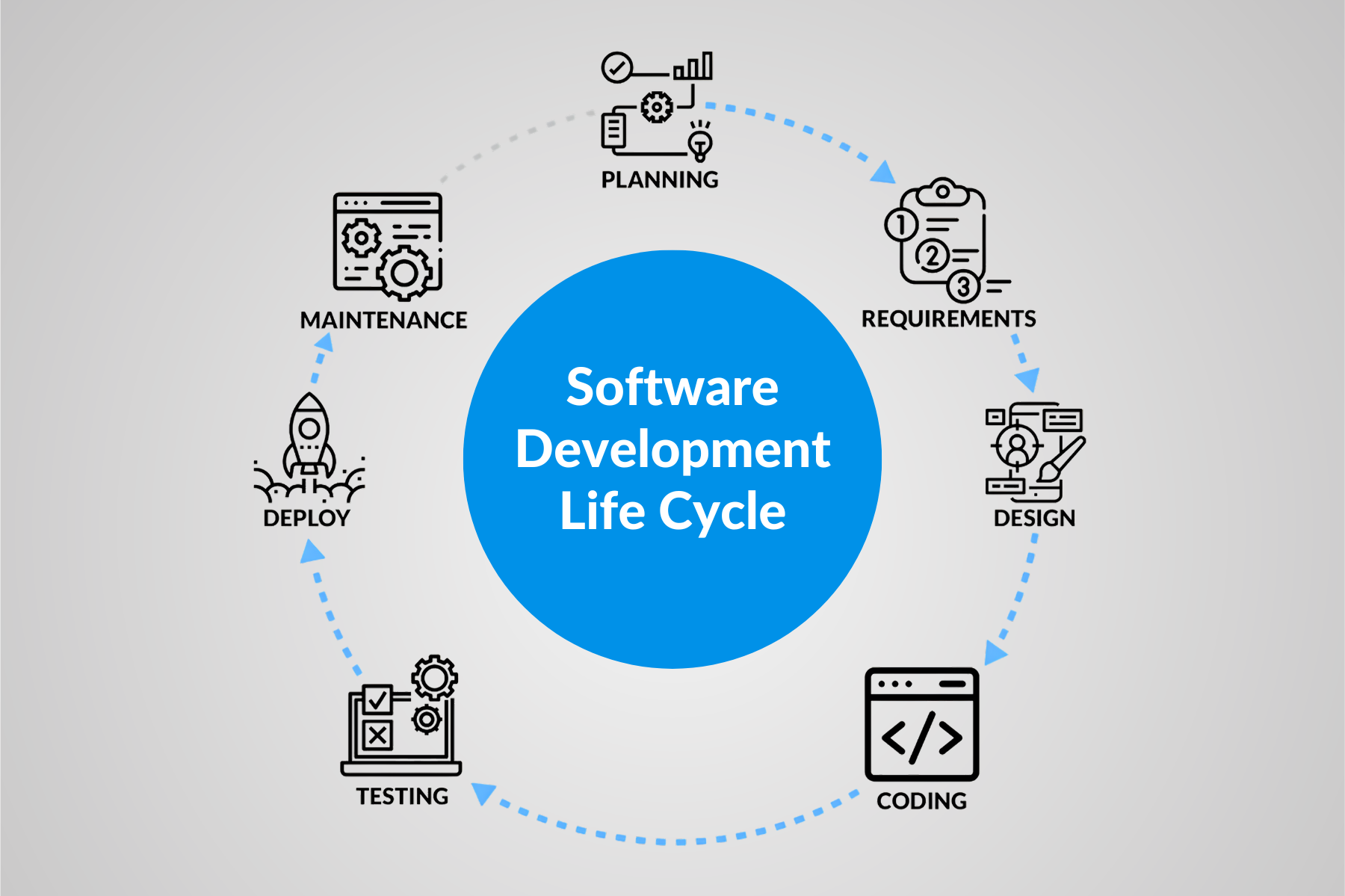Functional vs. Regression Testing: Understanding the Difference
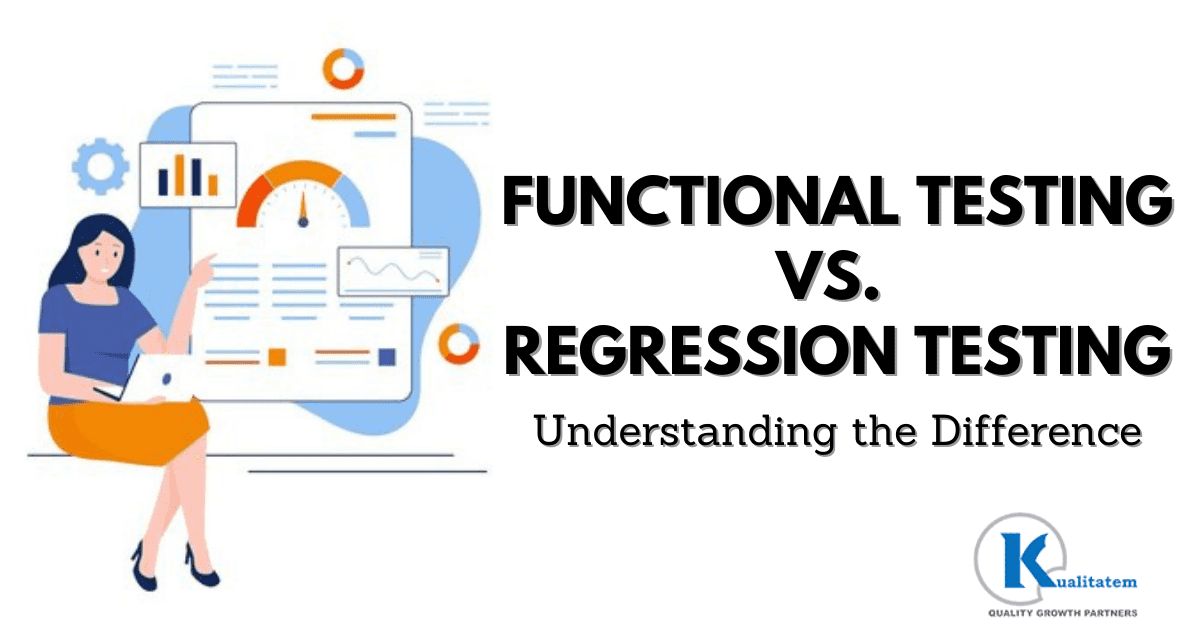
- November 3, 2025
- Zunnoor Zafar
As an SQA engineer, understanding the nuances of different testing methodologies is important. Doing so helps you deliver high-quality software products by implementing the suitable technique based on the requirements. The two most common methodologies in this realm are functional testing and regression testing.
Testers often report seeing them being mentioned together. But these testing types serve distinct purposes within the software development lifecycle and quality assurance processes.
For this purpose, we’ll explore the difference between functional testing and regression testing. You’ll get to know their importance in software quality, when to perform each and the challenges they present. So, let’s get right into it.
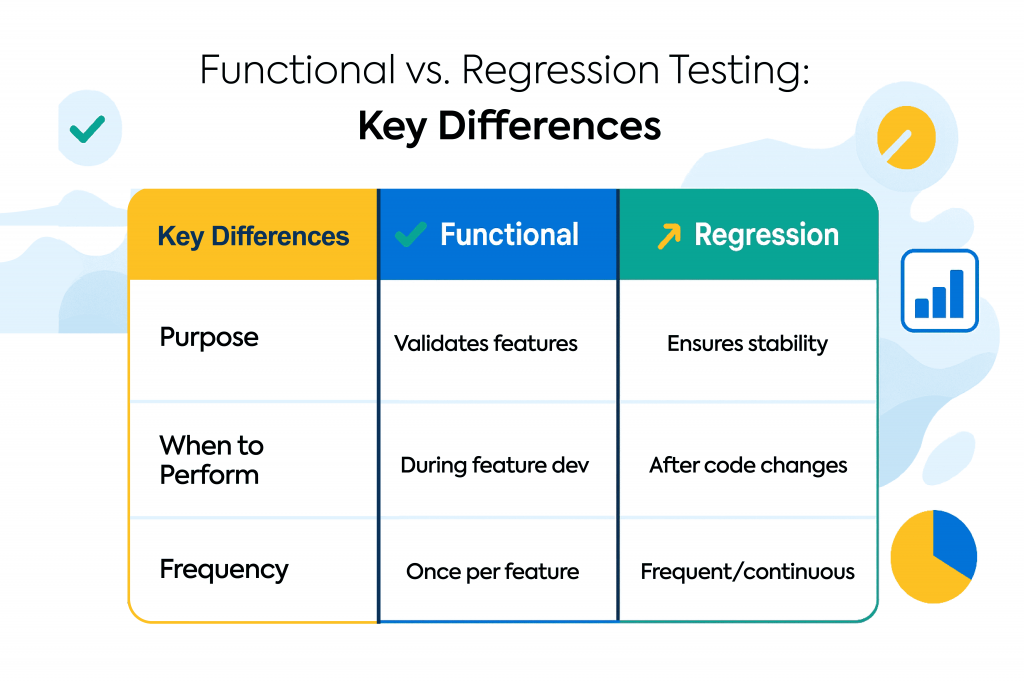
Key Takeaways
- Functional testing validates that new features and functionalities meet specified user requirements and behave as expected. It is usually conducted early in the development lifecycle.
- Regression testing ensures existing features continue to operate correctly after updates. These updates can be bug fixes or new feature additions. It is performed continuously throughout the software lifecycle.
- According to research, effective regression testing strategies can reduce post-release defects by up to 40%. Especially when combined with functional testing for comprehensive coverage.
- Functional tests are often executed manually or automated once features stabilize. Regression tests are primarily automated to support repeated runs in fast-paced CI/CD environments.
- Challenges in both testing types include selecting optimal test subsets and managing the time and cost constraints of full regression suites. Test suite health also has to be maintained, and organizational risk perceptions have to be balanced.
- Integrating AI and advanced automation tools into functional and regression testing significantly improves test coverage by up to 35%. Doing so also lessens the test design time by 50% and speeds up release cycles by 30%.
- Partnering with specialized testing providers like Kualitatem helps organizations design scalable, efficient testing strategies. Ones that include automation and CI/CD integration. Companies are able to easily overcome resource constraints and improve overall software quality.
What is Functional Testing?
The University of Minnesota published a paper that goes into detail on everything there is to know about functional testing. According to it, functional testing validates the software application against specified requirements. It ensures the system behaves as expected under various user scenarios.
Functional testing primarily focuses on:
- Testing new features or functionalities
- Verifying user requirements are met
- Validating the behavior of application components individually
Test cases are designed to cover all user-facing functions, while the system runs in a controlled environment. The results are then compared to expected outcomes, which help teams detect deviations, or, as you call it, defects. Both manual and automated approaches are commonly used.
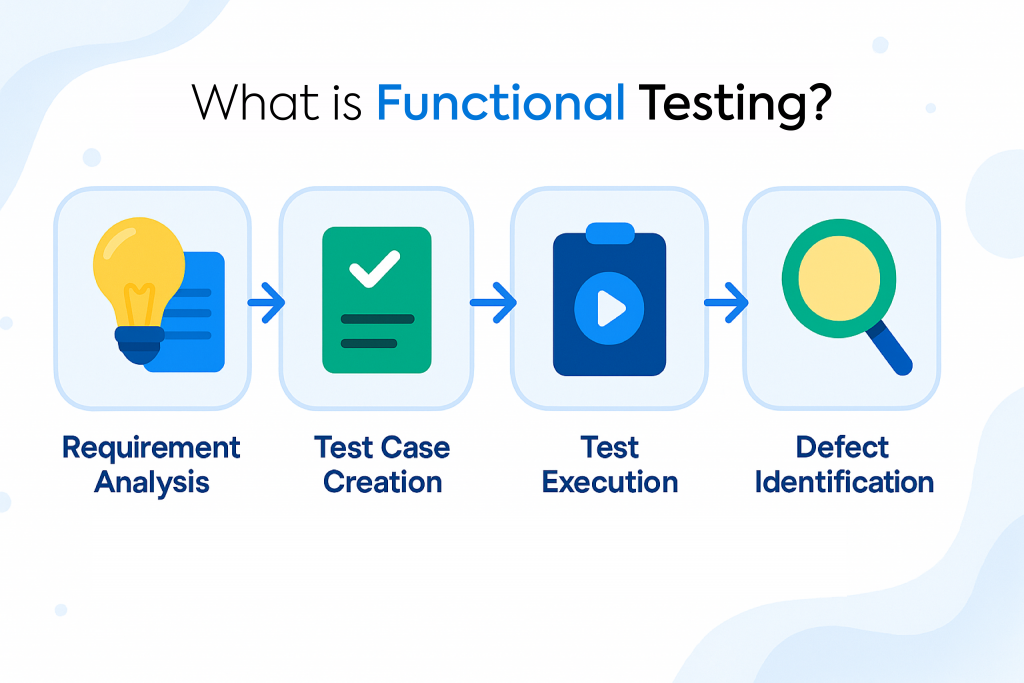
What is Regression Testing?
Qentelli has a whole paper on regression testing. It discusses the definition, methods, tools and best practices for this testing. According to it, regression testing is a quality assurance method focused on verifying software modifications.
In simple words, it is done to make sure that updates such as big fixes, new features or environment changes do not negatively affect existing functionalities. Regression testing ensures:
- Previously working features continue functioning after code changes
- No new defects are introduced by updates
- Stability and reliability of the software application over time
Regression testing targets areas impacted by code changes. Full or partial suites are run, depending on risk and priority levels. And when it comes to automation, it is highly favored due to the frequent execution needs. Especially in CI/CD pipelines.
You’re basically getting a safety net for software maintenance and iterative development. This helps you catch unintended side effects early.
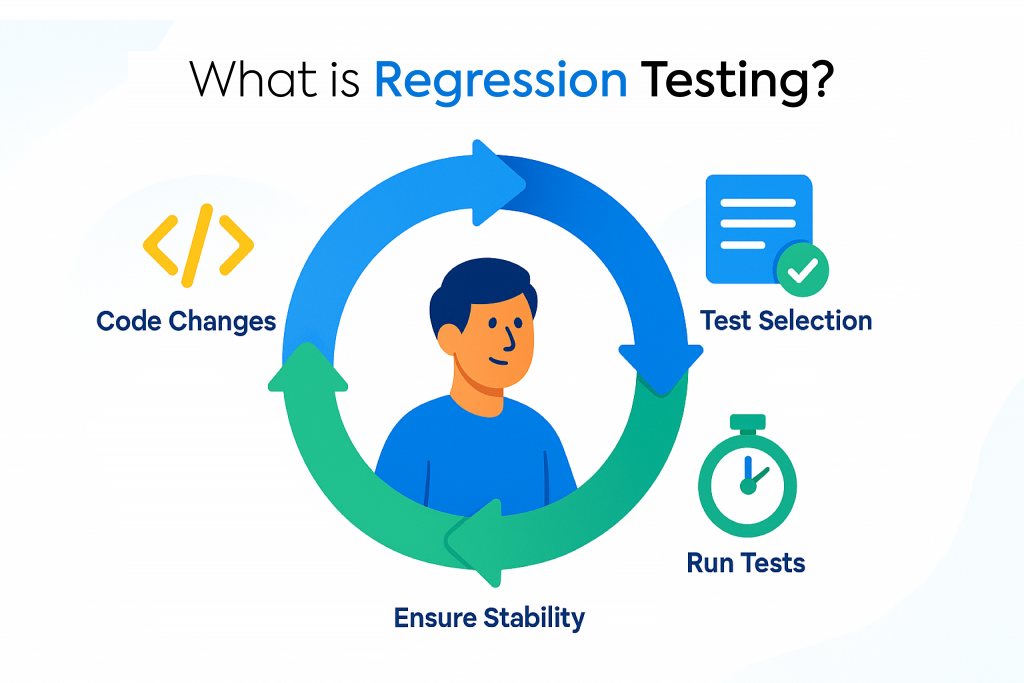
What is the Primary Goal for Each Testing Type?
A bite-sized goal analysis of functional and regression testing is as follows.
| Testing Type | Primary Goal |
| Functional Testing | Validate that the software meets requirements and behaves as expected by the users. |
| Regression Testing | Ensure existing functionality is not broken by recent changes. |
It’s worth mentioning that testers can either carry out these two testing types simultaneously or one by one. The choice is theirs. Also, when it comes to regression testing, it can be carried out fully or partially.
Functional vs. Regression Testing: Key Differences
| Aspect | Functional Testing | Regression Testing |
| Purpose | Validates software functionalities as per the requirements | Verifies no defects from updates or changes |
| When to Perform | During feature development and initial testing | After code changes, bug fixes, or releases |
| Scope | Specific functions, user requirements | Broad, encompassing affected existing features |
| Frequency | Once per feature or module | Repeated frequently to ensure ongoing stability |
| Automation Suitability | Can be manual or automated | Primarily automated due to repetitive nature |
| Focus | User requirements and business logic | Stability and bug prevention |
When Should Functional Testing be Performed?
Functional testing is most effective when integrated early and strategically within the software development cycle. Specifically, it should be applied during the initial feature development and unit testing phases. Here’s why:
- Early Feature Validation: Functional tests verify that as soon as features are developed, they perform according to specified requirements. This helps detect issues related to feature logic or missing functionality quickly.
- Pre-Integration Testing: By testing features early, before they are integrated into the broader system, function testing isolates defects. They stay within specific components, in turn making troubleshooting easier.
- Alignment with Unit Testing: Functional testing complements unit testing. It does that by focusing on validating the behavior of features from the user’s perspective. Rather than internal code correctness alone.
- Facilitate Continuous Feedback: Early functional testing enables rapid feedback loops between developers, testers and stakeholders. This leads to better collaboration and acceleration of issue resolution.
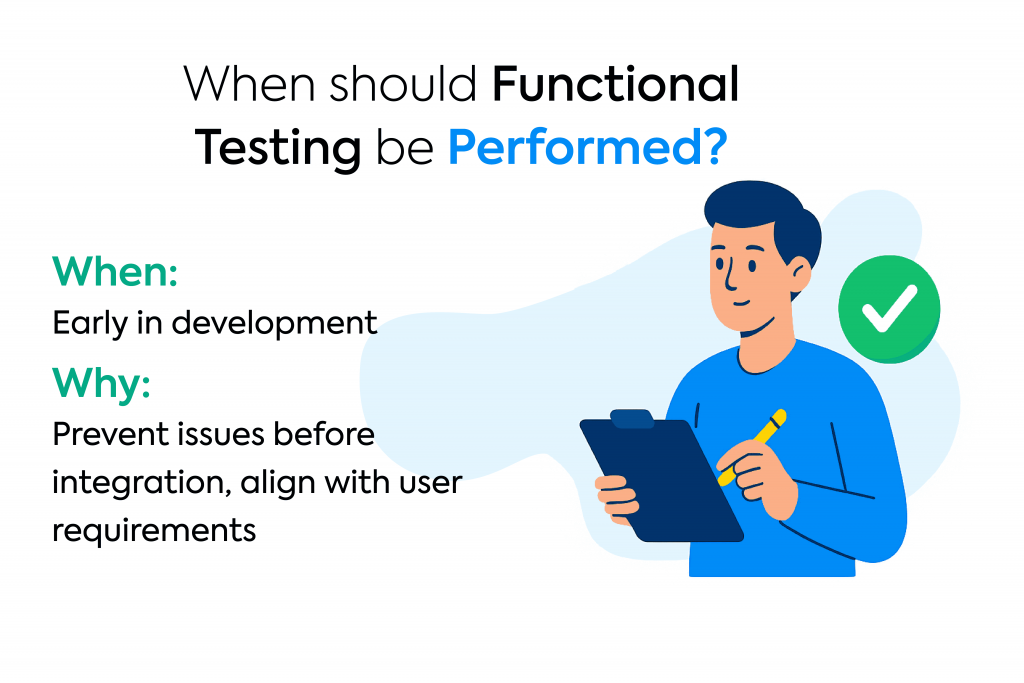
When Should Regression Testing be Performed?
Regression testing should be conducted systematically and frequently throughout the software development and release cycle. After every code change and bug fix. And that’s because the application stability and quality need to be maintained.
The following are the key reasons why it needs to be continuous.
- Early Defect Detection: Running regression tests regularly allows teams to identify bugs soon after changes are introduced. This prevents small issues from escalating into major problems.
- Stability & Reliability: Since software updates are frequent, regression testing confirms that new code changes don’t break existing features. A stable user experience is achieved.
- Continuous Integration and Delivery: Integrating regression testing into CI/CD pipelines supports fast, frequent releases. All while safeguarding against regressions. Continuous testing also provides immediate feedback on code quality, enabling agile development.
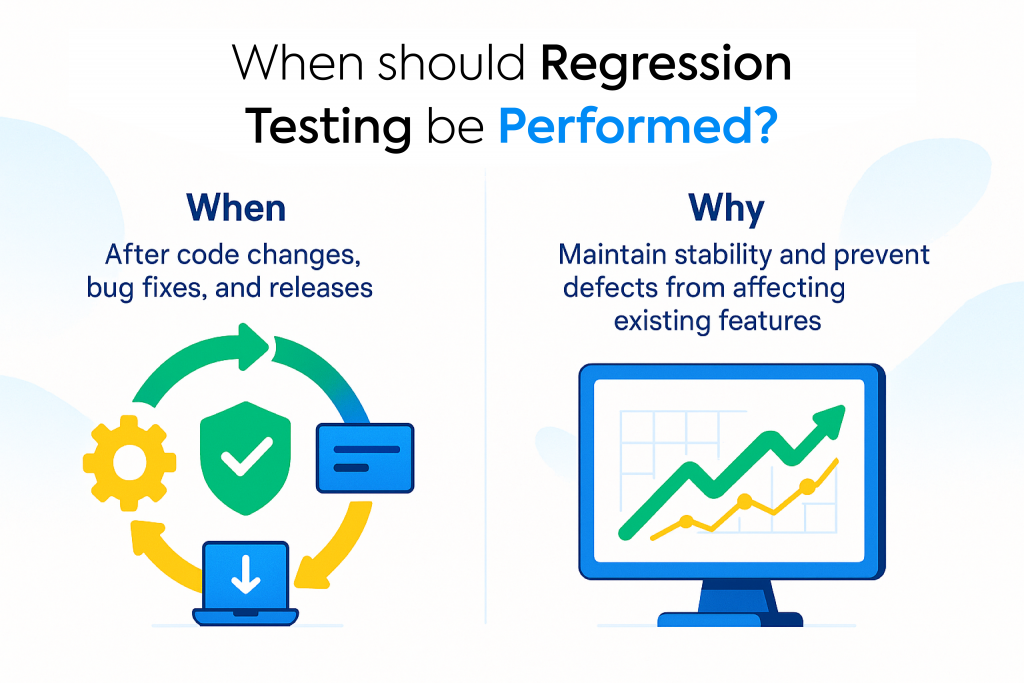
How Functional and Regression Testing Impact Overall Software Quality and User Experience
The research paper on regression analysis-based model by Hyder Abbas Musavi and others shows a 40% reduction in post-release defects for companies with effective regression testing strategies. And when combined with functional testing, the percentage goes even higher.
Functional and regression testing together form the backbone of a solid software quality assurance strategy. Their combined impact ensures not only the delivery of new features that work as expected. But also the long-term reliability and user satisfaction of the software product.
Here’s an expanded look at how these two testing methods together influence overall software quality and user experience:
- Comprehensive Coverage: Like we said before, functional testing focuses on verifying that new features meet specified requirements. On the other hand, regression testing ensures that existing functionalities continue to work correctly after these changes. Together, they provide extensive coverage across both new and existing software components.
- Enhanced User Satisfaction: These testing approaches help ensure the software consistently meets functional requirements and remains free from unexpected regressions. A smooth, predictable and satisfying user experience is achieved. The users can rely on the software to perform expected tasks without interruptions or errors.
- Quality-Driven Decision Making: The insights received from functional and regression tests help project stakeholders and decision-makers to make informed decisions. Particularly, ones that are about the readiness for release, prioritizing bug fixes and allocating resources efficiently.
- Real-World Validation: Functional testing scenarios often simulate real user behaviors. This means that testers can make sure the software can handle diverse inputs and workflows. Moving forward, regression tests verify these conditions continuously, securing reliability against future changes.
Test Plan for Regression Testing
A regression test plan outlines the strategy for executing regression tests. It includes:
- Scope of testing (full or partial regression)
- Selection criteria for test cases (priority, risk, affected modules)
- Automation strategy and tools, e.g., Selenium and Playwright.
- Schedule and frequency aligned with development cycles
- Roles and responsibilities in test execution and maintenance.
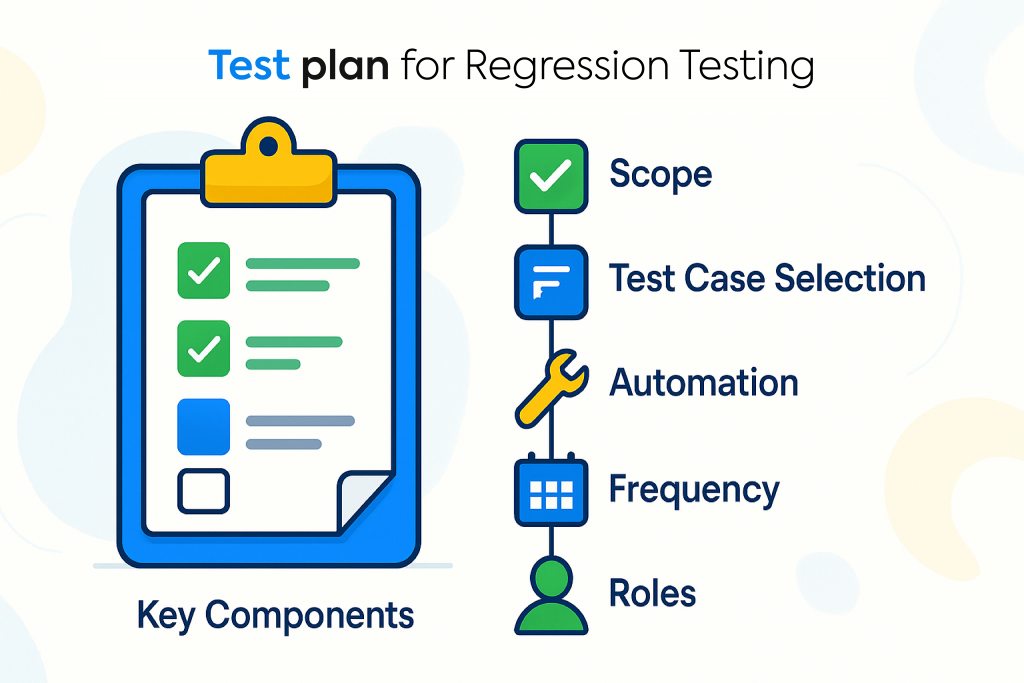
Try to consider all the aforementioned points when coming up with a regression plan. Because then there’s a good chance that you’ll be able to make efficient use of resources, minimize testing bottlenecks and guarantee coverage of important application paths.
Benefits of Functional and Regression Testing
Besides early defect detection and accelerated release cycles, functional and regression testing offer several other benefits. The following are some of them.
1. Reduction in Production Failures
Continuous regression testing lowers the risk of critical bugs reaching production. IBM data indicates that fixes applied post-deployment can cost up to 100 times more than during development.
Functional and regression testing jointly act as cost-saving measures by catching issues beforehand. This preserves the reputation and customer trust of your organization.
2. Better Developer Productivity
If functional and regression testing are automated and integrated into CI/CD pipelines, they can provide real-time feedback on code changes.
This enables developers to identify issues promptly. Rather than during manual QA stages, leading to more turnaround times and reduced rework.
3. Facilitation of Agile and DevOps Practices
Both testing types are foundational to agile and DevOps workflows. By now, you already know what the goal of each testing type is. Together, regression testing and functional testing enable continuous delivery. All without sacrificing quality.
4. Adaptibility to Complex Environments
Functional and regression testing help validate software performance across diverse environments and configurations. This is important for cloud, mobile and IoT applications.
The adaptability ensures a consistent user experience on different platforms and devices. No matter how complex they are.
5. Support for Compliance and Standards
Rigorous functional and regression testing assists organizations in meeting regulatory and quality standards. Such as ISO, GDPR and HIPAA.
Thorough testing documentation and repeatable suites provide you with the audit trails required for compliance verification.
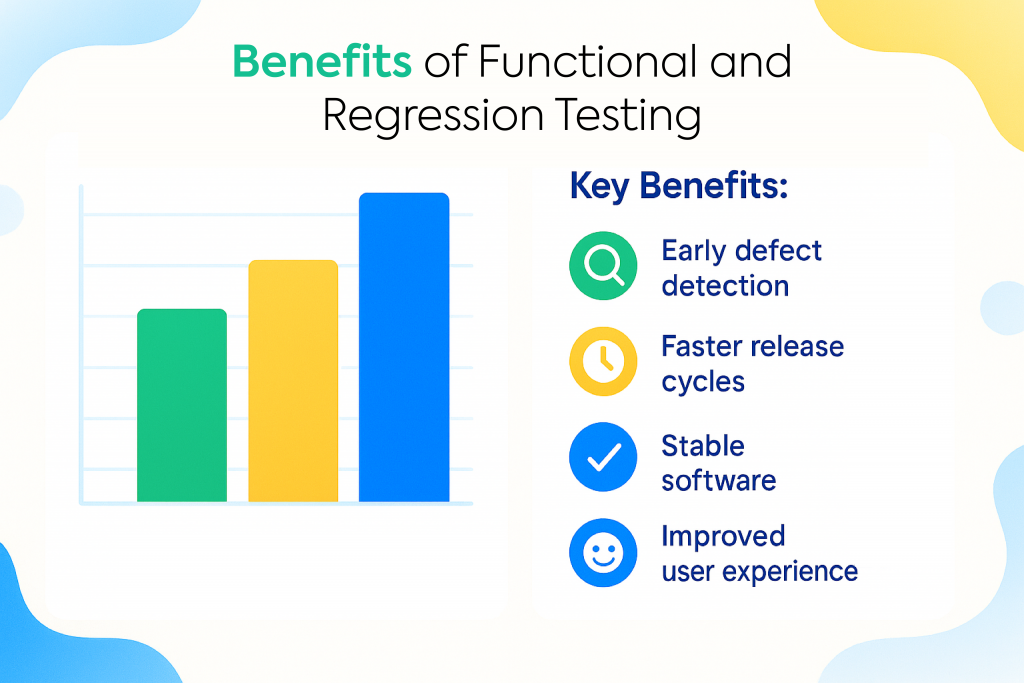
Challenges in Functional and Regression Testing
The following are some challenges we’ve seen testers face when they’re doing function and regression testing.
1. Complex Test Selection and Scope Definition
Selecting the right subset of test cases for partial regression testing is a major challenge. We’ve seen QA executives asking questions like: “How do you really know if you picked the right subset of tests? It’s always a gamble.”
Manual tracing across various code commits to identify impacted areas is time-intensive and error-prone. Many teams depend heavily on tribal knowledge. This creates risks when experienced personnel leave, forcing them to fall back to the costly practice of running regression suites frequently.
2. Time and Cost Constraints of Full Regression
Full regression suites are comprehensive, for sure. But they often require several hours to execute. Some teams report runtimes of six hours or more. “We can only afford that overnight, which slows down the sprint cycle,” said one QA, and this represents a common frustration.
The high execution time conflicts with agile delivery goals and strains resources. Especially when management demands full regression coverage without investments in expanding automation coverage.
3. Maintenance Burden of Automated Test Suites
As automated regression suites grow, maintenance becomes a substantial overhead. We’ve seen testers say, “The full regression suite is filled with brittle, ignored tests that no one maintains. We just run it to say we ran it.”
UI changes, obsolete workflows and flaky tests introduce instability. Continuous review and investment in test refactoring are needed to keep automation effective.
4. Organizational Dynamics and Risk Perception
Differences in responsibility between developers and QA teams create tension in regression approaches. We’ve seen this firsthand.
Developers often control partial regression tests linked to pull requests for rapid feedback. While QA teams maintain full regression as a quality gatekeeper. Management’s preference often leads toward full regression for better security. This sometimes happens at the expense of delivery speed.
Overcome Functional & Regression Testing Challenges with Kualitatem
To overcome the complexities of functional and regression testing, you need more than a strategy. Hands-on expertise and adaptive solutions are required. And that’s exactly what Kualitatem offers.
We specialize in delivering tailored functional and regression testing services. Partnering with us gets your organization:
- Robust Testing Strategies: We develop custom test plans aligned with your development cycles and business goals. Comprehensive quality coverage is ensured.
- Scalable Test Automation: Our experts use industry-leading tools like Selenium, Cypress and Playwright to build, as well as maintain, reliable automated test suites. Ones that scale with your product.
- Easy Integration with CI/CD Pipelines: Our testing services support continuous integration and continuous delivery frameworks. Fast, actionable feedback is provided so your software’s release cycle can be accelerated.
- High Test Suite Health and continuous Maintenance: Regular audits and updates are provided. So, your functional and regression tests stay effective, and maintenance overhead is avoided.
- Early Risk Detection: Our regression testing uncovers defects introduced by new code. This prevents costly downstream issues and protects the experience of your users.
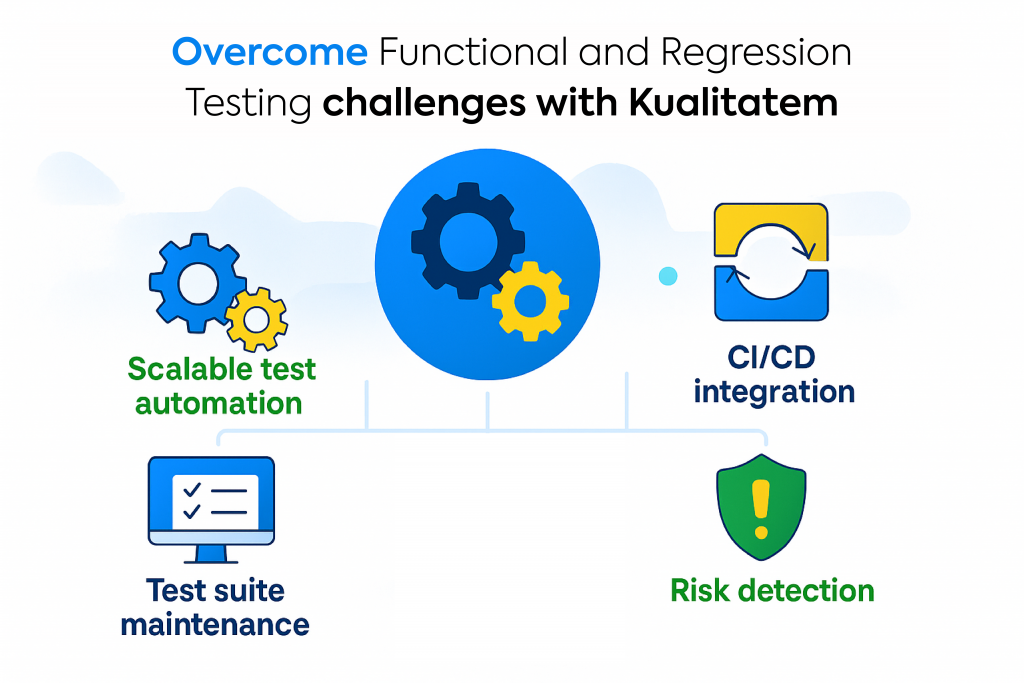
So, are you ready to improve your functional and regression testing processes?
Contact Kualitatem today to speak with our experts and discover how we can tailor a testing solution. One that fits your unique needs and accelerates your software success.
Conclusion
Functional and regression testing are important components of a software quality assurance strategy.
The purpose of functional testing is to ensure that the existing software, along with the new features, meets specified requirements and works as expected. Regression testing verifies that existing functionalities remain intact after updates.
Together, they improve software stability, user satisfaction and allow for quality-driven decision making. Testers are able to broaden coverage and detect defects early if functional and regression testing are done right.
There are a few challenges associated with these testing types, such as high execution time and maintenance. If these challenges are addressed, QA teams can further optimize their effectiveness.
FAQs
Q) What is the difference between functional testing and regression testing?
Functional testing validates new software features against requirements. On the other hand, regression testing ensures that modifications do not disrupt existing functionality.
Q) What are the 4 levels of testing?
The four levels include Unit Testing, Integration Testing, System Testing (including Functional Testing) and Acceptance Testing.
Q) What is the difference between regression testing and testing?
Regression testing is a subset focused on re-testing unchanged software parts after updates, whereas testing broadly encompasses all software validation activities.
Q) Is regression testing a part of non-functional testing?
No, regression testing is generally classified under functional testing as it verifies functional correctness post changes.


